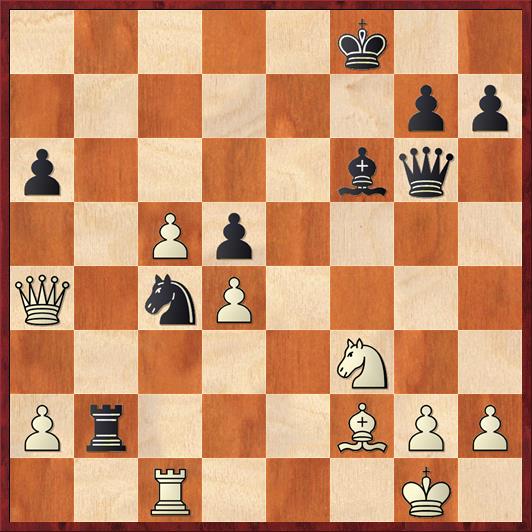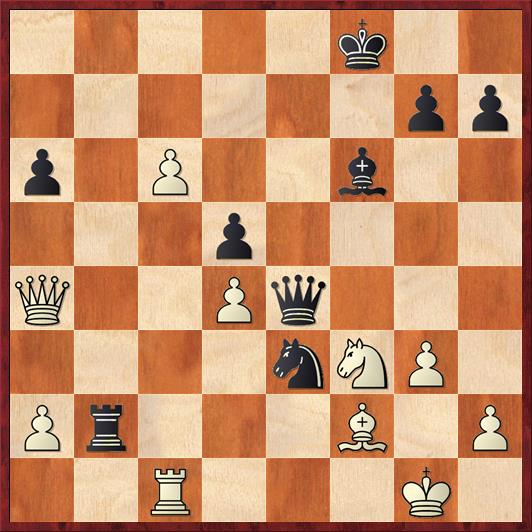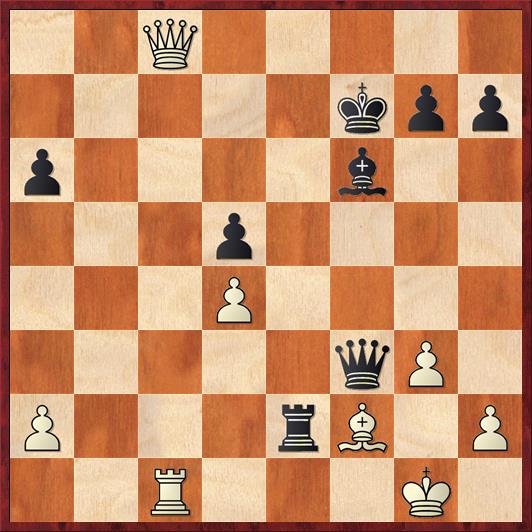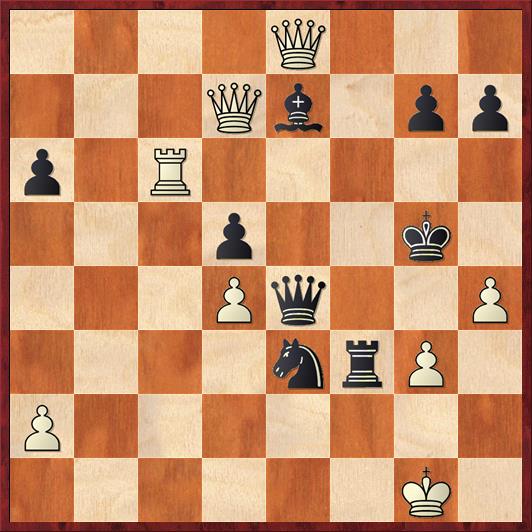In my last post I asked readers for examples of games with “two shining moments” — in other words, one fantastic, seemingly game-winning move for each player. Mike Splane sent me a link to a game he played against Agnis Kaugars in 1993 that meets the description — and more!
Both players were balancing over a precipice for the longest time, and in fact the computer finds several tactics that they missed. You might say that makes it an imperfect game, but I think the swings of fortune actually make it more exciting. But I’ll skip over most of them and take you right to the climax.
 Position after 34. Qa4. Black to move.
Position after 34. Qa4. Black to move.
FEN: 5k2/6pp/p4bq1/2Pp4/Q1nP4/5N2/Pr3BPP/2R3K1 b – – 0 34
Black (Kaugars) had blundered a pawn a few moves ago, and this led White (Mike) to become overconfident and a little bit sloppy. I think that he is quite a different player today than he was in 1993. One of Mike’s maxims today is that when you are winning or ahead, your first job is to take away all of your opponent’s counterplay. But that isn’t the way he played back then, and you can see that he has allowed Kaugars a tremendous amount of compensation: a rook on the seventh rank, a queen casting her baleful eye on the g2 pawn, and two active minor pieces. How can Kaugars exploit these advantages?
The answer is the move 34. … Ne3!, which Mike says “was a complete shock to me.” It shouldn’t have been such a shock, because this is what happens when you let your opponent have such active pieces. But psychologically, Mike was already chalking this game up as a win, and was not paying as much attention as he should have. Now, unexpectedly, he is in a fight for his life.
It would have been easy for White to go wrong here. For instance, 35. Ne1? loses to 35. … Rxf2! 36. Kxf2 Ng4+. The main point is that 37. Kg1 Qh6! threatens both check on h2 and the rook on c1. Loose pieces drop off!
Mike passed the first test: he played 35. g3!, the best defense. Now Kaugars played 35. … Qe4, and White seems to be in desperate straits. He can’t defend the knight on f3, and he can’t move it because of mate on g2 or the rook sac on f2. Mike finds an amazing solution, which is based on the idea of treating his knight and bishop as if they were already dead. The trouble for Black is that it takes some time to clear out all this dead wood and get to White’s king! That gives White time to turn his “berserker pawn” into a queen.
36. c6!! …
(See diagram.)
 Position after 36. c6. Black to move.
Position after 36. c6. Black to move.
FEN: 5k2/6pp/p1P2b2/3p4/Q2Pq3/4nNP1/Pr3B1P/2R3K1 b – – 0 36
This move was Mike’s “shining moment,” which appears to turn a loss into a victory, like a hail-Mary three-pointer at the buzzer. The first point is that if Black threatens mate in one with 36. … Qxf3?, then White’s queen arrives just in the nick of time with 37. Qa3+! Ke8 38. Qxe3+ Qxe3 39. Bxe3. It’s not clear that White is winning here, because the c-pawn is now a little bit weak, but at least White has all the winning chances.
The much more difficult question is what White will do after 36. … Rxf2?, which is in fact what Kaugars played in the game. Mike says that he worked out all the following variations before his 35th move. He spent more than thirty minutes on that move, and he writes that “The analysis was the deepest and most complicated I have ever had to do in my entire playing career.”
But there’s one thing that Mike missed! And Kaugars, too. In the above position Black is still winning! I’ll give you lots and lots of space to think about it. I am quite certain that I would never have found the winning move without a computer.
(lots of space)
(Don’t peek! Think!)
(more space)
Okay, here is the computer move:
36. … Kf7!!!!
Yes, you read that right. Four exclamation points!
I am not joining the Brian Wall School of Annotating, in which every move gets liberally festooned with three, four, five, six exclamation points. When you throw around that many exclamation points, they become devoid of meaning. It’s like when some Internet troll posts a comment in all capital letters.
Here is what I mean by four exclamation points.
! = An outstanding move.
!! = A brilliant move, far beyond the ordinary in at least one of these attributes: courage, depth, breadth, originality, subtlety, beauty, unexpectedness.
!!! = A one-in-a-million move. This means, literally, that if an average game lasts about 40 moves, a “triple exclam” should happen once in every 25,000 master games. Maybe we should be even more picky than that; a triple exclam should be the best human move of the year, in any given year.
!!!! = A superhuman move. This is a move that can only be thought of by a computer. By definition, it can never take place during a game between humans, and can appear only in the annotations.
To me, 36. … Kf7 is one of the best candidates I have ever seen for a superhuman move. Here both sides are attacking like maniacs and every tempo is critical. Black is only a couple tempi away from checkmating White. White is only a couple tempi away from queening his pawn. And in the midst of this chaos, Black takes a tempo… to move his king! There’s something James Bond-ian about it; it’s as if he’s in a burning building and stops to smoke a cigarette (perhaps lighting it from the flames that are shooting out of the walls).
So, having said that, what is the point of 36. … Kf7? Well, Black sees that he is vulnerable to checks on a3 and also on the back rank, so he steps out of the way of both of them in advance. Why does that help him? The main point is that if White continues with 37. Qa3 (not check!) Black will play 37. … Re2!! (not f2). And now White has no way to stop the two-move checkmate, … Qxf3 followed by … Qg2 mate, except to sacrifice the queen. But sacrificing the queen is okay if you’re going to get another one back! So we continue: 38. Qxe3!! Rxe3 39. c7 (forget about taking on e3, because the rook on c1 would fall) Re2 40. c8Q Qxf3 (diagram).
 Position after 40. … Qxf3 (analysis). White to move.
Position after 40. … Qxf3 (analysis). White to move.
FEN: 2Q5/5kpp/p4b2/3p4/3P4/5qP1/P3rB1P/2R3K1 w – – 0 41
After all the incredible events over the last few moves, we are now actually back to even material! It’s even White’s turn to move. Nevertheless, White is dead lost (or close to it — Rybka gives Black a 1.7-pawn advantage), because there is no good defense to the threat of … Bxd4.
White’s other main option after 36. … Kf7 is 37. c7, but now Black plays 37. … Qxf3 and threatens mate. If 38. Qd7+ Kg6 39. Qh3 Rxf2 is just too much.
In a sense, the point of 36. … Kf7 was to get White to show his cards first. Is the queen going to a3 or is the pawn going to c7? The reason that the much more obvious moves 36. … Qxf3? or 36. … Rxf2? are mistakes is that Black declares his intentions too soon and White gets the privilege of choosing the appropriate defense. Still, all of this is written with 20-20 hindsight. To figure that out in the heat of a game, while pausing to smoke a cigarette in the middle of a burning building, maybe just too much to expect of any human.
So we can scarcely blame Kaugars for playing 36. … Rxf2?, which looks like another “shining moment” kind of move. If White takes the sacrifice, he’s toasted as before: 37. Kxf2? Ng4+ 38. Kg2 Qe2+ 39. Kh3 Qxf3 etc.
But of course, Mike didn’t take the sacrifice. I’ve already told you that the knight and bishop are dead to him; their only value is the two tempi that it takes Black to remove them from the board. Instead he keeps pushing his pawn with 37. c7!! This took amazing cold-bloodedness and careful calculation. Perhaps the coolest variation is the one where Black takes the second piece: 37. … Rxf3 (37. … Qxf3 would allow mate by 38. c8Q+ followed by Q8e8+) 38. c8Q+ Kf7 (too late!) 39. Qad7+ Bd7 40. Qce8+ Kf6 41. Rc6+ Kg5 42. h4+ and wins. This fantasy position deserves a diagram. Frankly, this variation reminds me of bughouse chess, where new pieces descend on the board out of nowhere (such the queen on e8) and if you run out of checks, you lose. Fortunately, White didn’t run out of checks. If he had, he would have lost.
 Position after 42. h4+ (analysis). Black to move.
Position after 42. h4+ (analysis). Black to move.
FEN: 4Q3/3Qb1pp/p1R5/3p2k1/3Pq2P/4nrP1/P7/6K1 b – – 0 42
What happened in the game was a little bit more prosaic but it still demanded very precise analysis from White. Black continued 37. … Rg2+ 38. Kh1 Rc2 (not 38. … Rxh2+ because this is the one position where White can take the rook sac: 39. Kxh2 Ng4+ 40. Kh3 Nf2+ 41. Kg2 and Black is out of checks) 39. c8Q+ Rxc8 40. Rxc8+ Kf7 41. Qd7+ Kg6 (this is tantamount to resignation, but after 41. … Be7 42. Qe8+ Black is in a mating net similar to the one we just saw) 42. Qe8+ Qxe8 43. Rxe8. White has traded queens, is an exchange ahead, and has an easily won endgame. Mike handled the concluding stage very smoothly, and there is no need to go over it here.
What lessons can we learn from this?
- Prophylaxis first! Mike could have won the game without any of this agony (or ecstasy) if he had played a little bit more carefully earlier.
- Loose pieces drop off.
- Passed pawns can sometimes make a decisive difference in the middlegame. When a passed pawn becomes unstuck (and unstoppable) in the middlegame, I call it a “berserker pawn.”
- Sometimes the best thing a piece can do for you is simply to slow down the opponent’s attack by the one tempo it takes to capture the piece.
- Superhuman moves exist, but don’t waste time worrying about them. Your opponent may come back to you a week later and say, “My computer says I could have won that game.” It doesn’t matter. You weren’t playing against the computer.



{ 3 comments… read them below or add one }
Great write-up Dana. I agree with everything you have to say.
During the game I wasn’t sure that Black was winning after the alternate defense 35. Nd1 Rf2 36. Kf2 Ng4+ 37. Kg3!! Nh2+ 38. Kh2 Qh6+ 39. Kg3 Qc1 40. Nf3.
The computer can probably find a win for Black.
Believe it or not, I did see 36 … Kf7!! In fact, it was the only move I was afraid of. I spent a great deal of my thinking time, when considering 36. c6, on what to play against it. I was planning to play 37. Qa3. I concluded that I was okay after both 37 … Rf2 and 37 … Qf3.
I even saw the line 37 … Re2 38. Qe3 Re3 39. c7 Qf3 40. c8=Q+ Kf7. I couldn’t clearly calculate what was happening in this position, but I assumed (hoped) I would find some checks to save myself. Looking at it today the best I can do is to go into a pawn-down ending, so I have to agree that this is winning for Black..
I was also fairly confident that Augnis would not see all of this and would go wrong somewhere. Because he was starting to run short of time after his long think on move 31 I concluded that 36. c6 might be flawed but it was by far the best practical chance to win the game. (I asked myself the Mike Splane question.)
I did miss his move 38… Rc2 in my analysis. Fortunately it was not a game-changer.
Thanks for bringing this wonderful game to the attention of the public. It is a masterpiece of fighting chess by both players.
It’s been 23 years, but I’m starting to recall what I planned to play in the critical line
36. c6 Kf7 37 Qa3 Re2 38. Qe3 Re3 39. c7 Qf3 40. c8=Q+ Kf7. This reaches is diagram 3, where Dana writes
“After all the incredible events over the last few moves, we are now actually back to even material! It’s even White’s turn to move. Nevertheless, White is dead lost (or close to it — Rybka gives Black a 1.7-pawn advantage), because there is no good defense to the threat of … Bxd4.”
I was going to play another queen sacrifice
41. Qb7+ Kg6 42. Rf1 Bd4 43. Qa6+ K moves 44. Qe3 Qe3 45. Bd4 Qa2.
I’m sure the computer would be able to win this for Black, but I’m not sure that Augnis could have. The key point is White looks like he could have a fortress draw if he can just give up the bishop for the d5 pawn. That would have been an appropriate result for such a great game.
BTW, Frisco Del Rosario called this “Mike Splane’s Immortal Game.” Thanks Frisco.
39. c8Q+ Rxc8 40. Rxc8+ Kf7 41. Qd7+ Kg6 (this is tantamount to resignation, but after 41. … Be7 42. Qe8+ Black is in a mating net similar to the one we just saw)
If you will indulge me, I’d like to show this variation too, since it was a critical piece of my analysis when I played 36. c6, and the surprising and stellar move 44 was very hard to see in advance It was finding this beautiful last piece of the puzzle that made me decide to play 36. c6.
36. c6 Rf2 37. c7 Rg2+ 38. Kh1 Rc2 39. c8Q+ Rxc8 40. Rxc8+ Kf7 41. Qd7+ Be7 42. Qe8+ Kf6 43. Qh5+ g5 44. Qh3+!!
In my initial analysis I got fixated on analyzing 44. Qh7+ and it took me quite a while to see this move. Now Black can interpose on g4 with three different pieces, but in every case 45. Qh7 is mate.